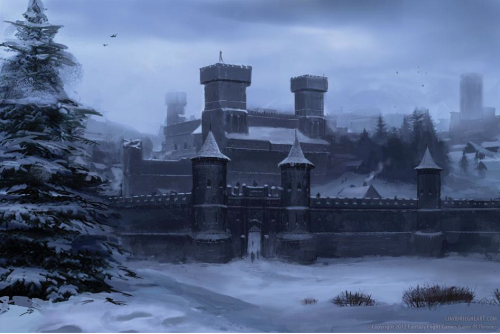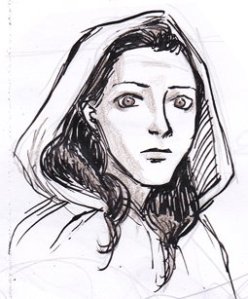
As discussed in Radio Westeros Episode 18
In Theon Greyjoy’s chapter “A Ghost in Winterfell” in ADwD, we find one of the great minor mysteries of the ASoIaF fandom. It begins with a series of deaths. A Ryswell man at arms, Aenys Frey’s old squire, and a Flint crossbowman. Theon does not believe any of the excuses made for these deaths, thinking to himself each time that foul play was a more likely answer.
When Ramsay Bolton’s own man Yellow Dick is found dead, with his actual member cut off and stuffed into his mouth, there can be no doubt that a bad actor is responsible for these deaths. Things are starting to go badly wrong for Roose Bolton, the snow is making the men anxious, the Freys and Manderlys are fighting and the stables have collapsed. It is during this chaos and friction that Theon flees a meal in the great hall and has a curious encounter.
When Theon steps outside he has a moment of peace in the falling snow that is strangely evocative of Sansa’s “snow castle” scene from the Eyrie. Then he walks on and meets a man:
Farther on, he came upon a man striding in the opposite direction, a hooded cloak flapping behind him. When they found themselves face-to-face their eyes met briefly. The man put a hand on his dagger. “Theon Turncloak. Theon Kinslayer.”
“I’m not. I never … I was ironborn.”
“False is all you were. How is it you still breathe?”
“The gods are not done with me,” Theon answered, wondering if this could be the killer, the night walker who had stuffed Yellow Dick’s cock into his mouth and pushed Roger Ryswell’s groom off the battlements. Oddly, he was not afraid. He pulled the glove from his left hand. “Lord Ramsay is not done with me.”
The man looked, and laughed. “I leave you to him, then.”
That short passage has inspired the eternal question — who is the hooded man? Many identity theories have been floated about the fandom, from Benjen Stark to Hal Mollen to Brynden “Blackfish” Tully. And while there is some value in ideas like Robett Glover, the brother of the lord of Deepwood Motte who was last seen trying to raise troops in White Harbor, and an idea which proposes the hooded man is simply in Theon’s imagination, our call is someone much closer to home, someone who would have very good reason to be in Winterfell, who may be much changed from the last time Theon saw him, and who Theon actually thinks is dead, making him a perfect candidate for an alternate interpretation of the chapter title. Harwin, son of Hullen, is both a possible alternate as “A Ghost in Winterfell” and a strong candidate for being the hooded man Theon encounters.
Probably the first question to address is why Harwin? That answer lies with Lady Stoneheart. Starting in ASoS, in the Merrett Frey epilogue, it’s made clear that she and the BwB are searching for her daughter Arya in the Riverlands. Remember that, besides Sandor Clegane, the BwB are the last people to knowingly see Arya Stark alive. The search continues into AFfC, when the BwB question Brienne about Arya, and we also learn that they have been gathering orphans in the Riverlands and housing them at the Inn at the Crossroads. It’s been speculated this is most likely an effort to discover Arya among the orphaned and displaced young people of the Riverlands.
Lady Stoneheart and the BwB would know that Arya was last seen with Sandor Clegane prior to the Red Wedding, and they will have also heard the news that some weeks after the Red Wedding, Roose Bolton set out for the north with a young woman in a closed carriage, reputed to be Arya Stark being taken home to marry his son Ramsay. In that light, it makes perfect sense that Lady Stoneheart would send a spy to Winterfell to see if this was truly her daughter, and if so to effect her rescue. Who better to send than the one member of the BwB who not only knew Arya well, but grew up in Winterfell and was an expert horseman?
Harwin is last mentioned by name in AFfC when Thoros tells Brienne that Harwin begged him to raise Catelyn Stark when they discovered her in the river three days after her death. And while there is a “young northman” in the cave when Brienne is brought before Lady Stoneheart, we think there’s a chance that young man is Hal Mollen, Catelyn’s sworn sword who was last seen heading into the Neck with Ned’s bones in ACoK.
The young man in the Brienne scene, whose voice is “frosted with the accents of the north”, is never identified by name. There has been opportunity for Hal to have rejoined his lady’s service, since Lady Stoneheart is noted to have been in Hag’s Mire and the Neck recently. In addition, it’s interesting that this young man says to Brienne:
“Can it be that my lady has forgotten that you once swore her your service?”
Hal Mollen witnessed Brienne’s oath to Lady Catelyn in ACoK, and since this comment seems to come from personal knowledge rather than something Lady Stoneheart said, we give pretty good odds to this man being Hal Mollen, and to Harwin having been sent on a mission sometime earlier, possibly during that trip into the Neck. But the theory doesn’t hinge upon that being true, since by most reckonings nearly two months pass between Brienne’s trial and the hooded man sighting. This would seem to be more than enough time for an expert horseman who knows the lay of the land well to make his way to Winterfell.
So having established motive and opportunity for Harwin, let’s look at the scene itself. It’s not immediately clear if Theon recognises the man. He wonders if this is the killer who has claimed four victims to that point, and thinks of him only as “the man.” But it’s very obvious the hooded man knows him. He clearly recognises Theon, and calls him “Turncloak” and “Kinslayer” — epithets that one could certainly expect from someone who lived in the Winterfell household. Theon denies being a kinslayer as usual, since he knows he didn’t kill Bran and Rickon. And as usual this is met with disgust and the hooded man says “False is all you were” and wonders “How is it you still breathe?” Now, we know that Theon’s torture by Ramsay was known in the Riverlands, Roose had made no secret of it. The man doesn’t seem surprised, and even laughs, when he sees Theon’s maimed hand, and seems to take some pleasure in leaving Theon to Ramsay.
These reactions seem to be all in keeping with what one would expect from Harwin. But what about Theon? It’s possible he wouldn’t recognise Harwin whom he hasn’t seen in several years, especially when we recall that Harwin was much changed and Arya barely recognised him when she first met the BwB. But it’s also possible that he does recognise him. And that is the really intriguing possibility because while Theon hasn’t seen Harwin in years, he does think of him.
In ADwD, in the chapter following his encounter with the hooded man, Theon is thinking about the ghosts that inhabit Winterfell and we get this:
That was long ago, though. They were all dead now. Jory, old Ser Rodrik, Lord Eddard, Harwin and Hullen, Cayn and Desmond and Fat Tom, Alyn with his dreams of knighthood, Mikken who had given him his first real sword. Even Old Nan, like as not.
So it seems that Theon assumes that all of the men who went with Ned perished in King’s Landing, but Harwin is the only person in his thoughts that’s actually alive. We think we’re alerted to this mistake on Theon’s part for a reason. Consider that while the chapter title “A Ghost in Winterfell” clearly applies to Theon, it’s made very plain in his thoughts that he thinks of himself as only one of very many ghosts: “there are ghosts in winterfell, and I am one of them.” Now if we consider that these chapter titles sometimes do have alternate meanings, and imagine what Theon would think if he saw Harwin, who he thinks is dead… the alternate meaning for this chapter title becomes very clear. The hooded man would literally appear to be a ghost to Theon, who is already spending a lot of time musing about ghosts and wondering about the voice he is hearing from the weirwood tree. In that light some lines that come immediately after the encounter with the hooded man make a lot of sense. First he thinks “He was trapped here, with the ghosts” and then “Leave Winterfell to me and the ghosts” and finally, when surprised in the godswood by Abel’s women:
“The ghosts,” he blurted. “They whisper to me. They … they know my name.”
While the heart tree has been speaking to him in Bran’s voice, we think he has another ghost in mind as well. Imagine Theon, already haunted by the ghosts he created and hearing a voice speaking to him from the weirwood tree, seeing someone he has thought dead for these last two years. Might be good cause for him to think the ghosts are talking to him. Then in Theon’s TWoW spoiler chapter, when recalling how he tried to explain his story to Asha when they met in the snow, Theon thinks “He told her how he bedded down with Ramsay’s bitches, warned her that Winterfell was full of ghosts.”
Warning his sister “that Winterfell was full of ghosts” is very interesting in light of this theory that Theon had an encounter with a man he would consider a ghost. Let’s now provide some clarity on the other options that have been identified. One good question is why rule out other candidates like Robett Glover, Hal Mollen, the Blackfish and Benjen Stark? The obvious answer is that not only would Theon have recognised all of those men, having seen most of them recently during the fighting in TWot5K, but that he has never been shown to think any of them are dead, as he has Harwin, and so his reaction to seeing them might have been much different. One other thing about Harwin as an option that is important is that neither Roose, nor any of the lords or soldiers who are with him would be expected to recognize him, as they would Glover, Tully or Benjen Stark. Even Hal Mollen, who was Robb’s standard bearer when the northmen left Winterfell in AGoT, would be a familiar face to many. Harwin could thus easily blend in with the grooms, servants and freeriders that Winterfell is noted to be teeming with.
Consider also Theon’s reaction, wondering “if this could be the killer, the night walker who had stuffed Yellow Dick’s cock into his mouth and pushed Roger Ryswell’s groom off the battlements.” There is an almost supernatural feeling to this, and the fact that he feels no fear is appropriate given the fact that he seems so comfortable with his “ghosts.”
Speaking of Theon’s suspicion that the hooded man could be the killer, we think it unlikely. After Theon’s various interactions with Abel’s women it seems pretty clear that they were responsible for the Ryswell man at arms, Ser Aenys Frey’s squire, the Flint crossbowman and Yellow Dick. Since there isn’t anything we know of in the political situation at Winterfell to connect those four men, we surmise that they had some knowledge that made them dangerous. Since all were found outside, we further assume it was something they saw that marked them for death.
But what about Little Walder? Rowan denies that his death was down to Abel’s washerwomen, implying they are responsible for the others. We can’t rule them out because the body was discovered in the vicinity of the tower Abel met Theon in the night of the murder, but we definitely think there could be a second murderer in Winterfell who killed Little Walder. We find it highly suspicious that Big Walder is noted to be spattered in blood, when it’s just been stated that Little Walder’s blood was frozen, due to the body being found in a snowdrift. So while we can’t rule out one of Abel’s women or the hooded man as the killer, we do think that Big Walder, who was so quick to implicate a knight from White Harbor, is definitely a strong suspect in that murder.
In conclusion, Harwin as the hooded man makes thematic sense and is well supported by the text, but it appears that it’s probably best to look elsewhere for the perpetrators of the mysterious deaths that take place in Winterfell as tensions rise to the boiling point and Roose Bolton commands a snowy march to meet Stannis Baratheon in battle.




